
The Ediacaran Period is a geological period that spans 96 million years from the end of the Cryogenian Period 635 million years ago (Mya), to the beginning of the Cambrian Period 538.8 Mya. It marks the end of the Proterozoic Eon, and the beginning of the Phanerozoic Eon. It is named after the Ediacara Hills of South Australia.
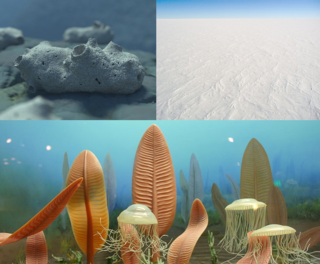
The Neoproterozoic Era is the unit of geologic time from 1 billion to 538.8 million years ago.
The Precambrian is the earliest part of Earth's history, set before the current Phanerozoic Eon. The Precambrian is so named because it preceded the Cambrian, the first period of the Phanerozoic Eon, which is named after Cambria, the Latinised name for Wales, where rocks from this age were first studied. The Precambrian accounts for 88% of the Earth's geologic time.

Charnia is a genus of frond-like lifeforms belonging to the Ediacaran biota with segmented, leaf-like ridges branching alternately to the right and left from a zig-zag medial suture. The genus Charnia was named after Charnwood Forest in Leicestershire, England, where the first fossilised specimen was found. Charnia is significant because it was the first Precambrian fossil to be recognized as such.
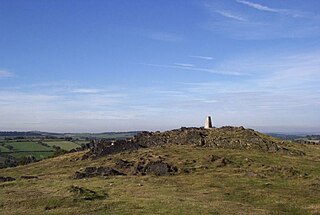
Charnwood Forest is a hilly tract in north-western Leicestershire, England, bounded by Leicester, Loughborough and Coalville. The area is undulating, rocky and picturesque, with barren areas. It also has some extensive tracts of woodland; its elevation is generally 600 feet (180 m) and upwards, the area exceeding this height being about 6,100 acres (25 km2). The highest point, Bardon Hill, is 912 feet (278 m). On its western flank lies an abandoned coalfield, with Coalville and other former mining villages, now being regenerated and replanted as part of the National Forest. The M1 motorway, between junctions 22 and 23, cuts through Charnwood Forest.
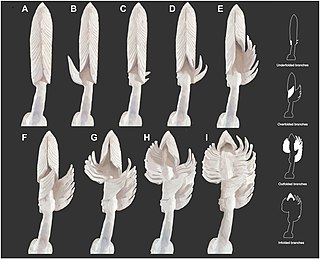
Charniodiscus is an Ediacaran fossil that in life was probably a stationary filter feeder that lived anchored to a sandy sea bed. The organism had a holdfast, stalk and frond. The holdfast was bulbous shaped, and the stalk was flexible. The frond was segmented and had a pointed tip. There were two growth forms: one with a short stem and a wide frond, and another with a long stalk, elevating a smaller frond about 50 centimetres (20 in) above the holdfast. While the organism superficially resembles the sea pens (cnidaria), it is probably not a crown-group animal.
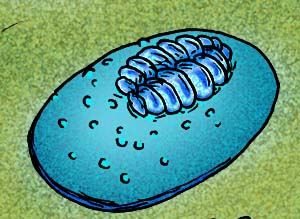
Cephalonega stepanovi is a fossil organism from Ediacaran deposits of the Arkhangelsk Region, Russia. It was described by Mikhail A. Fedonkin in 1976

Aspidella is an Ediacaran disk-shaped fossil of uncertain affinity. It is known from the single species A. terranovica.

Bradgatia linfordensis is a bush-like Ediacaran fossil. It consists of six or more fronds radiating from a central anchor point at the base. It superficially resembles a compressed cabbage in appearance, although in reality it had a more intricate, fractal mode of organisation. When multiple fossils are found together they are regularly spaced out rather than randomly distributed. It dominates the ecosystem at 8 to 22 cm above the mud surface at the bottom the sea where it grew. It was over-towered by Charnia and Charniodiscus which grew nearby.
Trevor David Ford, OBE was an English geologist, specialising in speleology, and an author. He was a Senior Lecturer in the Geology Department of the University of Leicester, and also Associate Dean of Science.

The Ediacaranbiota is a taxonomic period classification that consists of all life forms that were present on Earth during the Ediacaran Period. These were composed of enigmatic tubular and frond-shaped, mostly sessile, organisms. Trace fossils of these organisms have been found worldwide, and represent the earliest known complex multicellular organisms.
Roger Mason is an English geologist. He is known as the discoverer of Ediacaran fossils, although it was later found that a then 15-year-old schoolgirl named Tina Negus had discovered the first Charnia fossil a year before he did. He is now a professor at the China University of Geosciences at Wuhan, China.

Vendiamorpha is a class of extinct animals within the Ediacaran phylum Proarticulata.
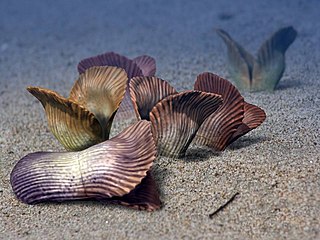
Ernietta is an extinct genus of Ediacaran organisms with an infaunal lifestyle. Fossil preservations and modeling indicate this organism was sessile and “sack”-shaped. It survived partly buried in substrate, with an upturned bell-shaped frill exposed above the sediment-water interface. Ernietta have been recovered from present-day Namibia, and are a part of the Ediacaran biota, a late Proterozoic radiation of multicellular organisms. They are among the earliest complex multicellular organisms and are known from the late Ediacaran. Ernietta plateauensis remains the sole species of the genus.

Charnwood Lodge is a 134.2-hectare (332-acre) biological and geological Site of Special Scientific Interest in Charnwood Forest, east of Coalville in Leicestershire. It is a national nature reserve, and contains two Geological Conservation Review sites. It is managed by the Leicestershire and Rutland Wildlife Trust.

Arumberia is an enigmatic fossil from the Ediacaran period originally described from the Arumbera Sandstone, Northern Territory, Australia but also found in the Urals, East Siberia, England and Wales, Northern France, the Avalon Peninsula and India. Several morphologically distinct species are recognized.

Pambikalbae is a monospecific genus known from the Ediacaran Period of South Australia. Its morphology resembles the morphology of colonial cnidarians, such as sea pens or siphonophores.
Hadrynichorde is a frondose organism from the Ediacaran period discovered in Newfoundland, Canada. It is a sessile, benthic marine organism. resembling modern sea whips.
Hylaecullulus fordi is a species of Ediacaran petalonamid from the Charnwood Forest of Leicestershire, England that serves as an important rangeomorph because of its multifoliate anatomy, known from its fossils. Its overall body plan is similar to that of a goblet, from which its name, Hylaecullulus, derives.













